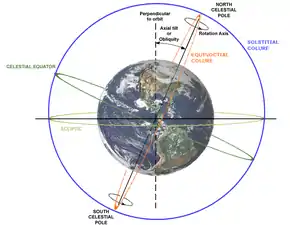Colure
Colure, in astronomy, is either of the two principal meridians of the celestial sphere.[1]

Orange = equinoctial colure
Blue = solstitial colure
Blue = solstitial colure

G = equinoctial colure
H = solstitial colure
H = solstitial colure
Equinoctial colure
The equinoctial colure is the meridian or great circle of the celestial sphere which passes through the celestial poles and the two equinoxes:[1] the first point of Aries and the first point of Libra.
Solstitial colure
The solstitial colure is the meridian or great circle of the celestial sphere which passes through the poles and the two solstices:[1] the first point of Cancer and the first point of Capricorn. There are several stars closely aligned with the solstitial colure: Pi Herculis, Delta Aurigae, and Theta Scorpii. This makes the solstitial colure point towards the North Celestial Pole and Polaris.
References
- This article incorporates text from a publication now in the public domain: Chisholm, Hugh, ed. (1911). "Colure". Encyclopædia Britannica. Vol. 6 (11th ed.). Cambridge University Press. p. 748.
- Harley, John Brian; Woodward, David (1987). Cartography in the Traditional Islamic and South Asian Societies. The History of cartography. Vol. 2. University of Chicago Press. p. 28. ISBN 978-0-226-31635-2. OCLC 13456456. OL 9455351M.
- Geminus; Evans, James; Berggren, J. L. (2006). Geminos's Introduction to the phenomena: a translation and study of a Hellenistic survey of astronomy. Princeton University Press. p. 130. ISBN 978-0-691-12339-4. OCLC 70232402. OL 15978783M.
- Ovason, David (1999). The Secret Architecture of our Nation's Capital. HarperCollins. p. 98. ISBN 978-006095368-3. OCLC 50409366.
- Kaler, Jim. "Pi Aurigae." Pi Aurigae. N.p. 22 Feb. 2008. Web.
This article is issued from Wikipedia. The text is licensed under Creative Commons - Attribution - Sharealike. Additional terms may apply for the media files.